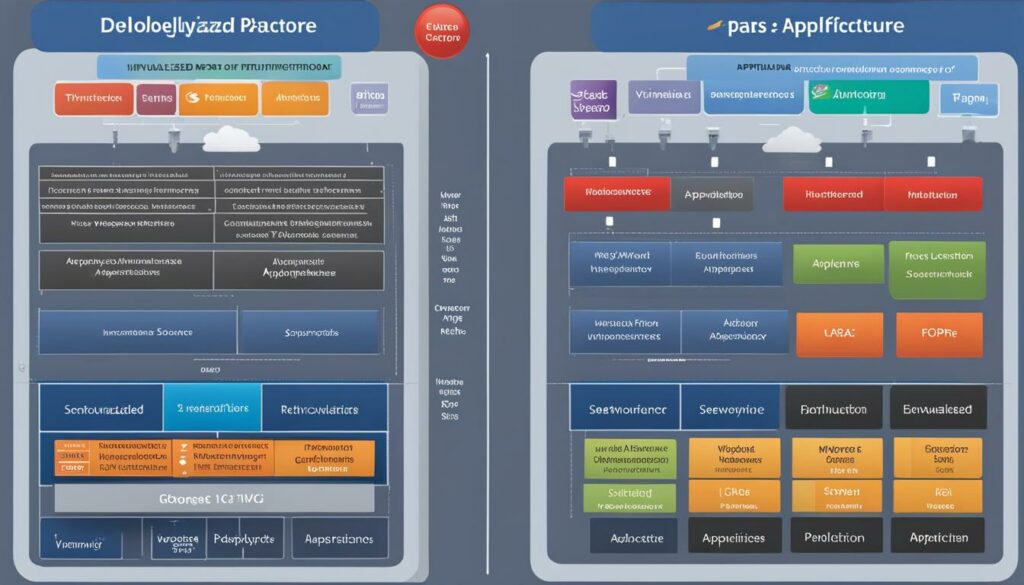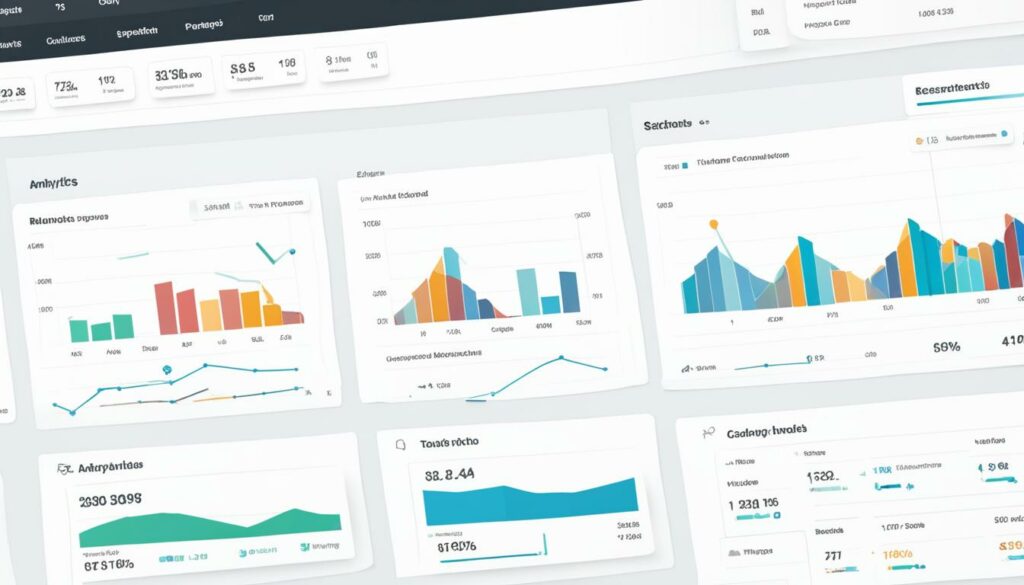Welcome to the world of cloud computing, where Infrastructure as a Service (IaaS) and Platform as a Service (PaaS) are two essential components. To make the most of cloud services, it’s crucial to understand the differences, benefits, and features of IaaS and PaaS and how they fit into your cloud deployment models. Let’s dive in and explore the key aspects of IaaS and PaaS.
Key Takeaways:
- IaaS and PaaS are two important cloud service models in cloud computing.
- Understanding the differences between IaaS and PaaS helps in selecting the right option for your cloud strategy.
- IaaS provides organizations with control over infrastructure resources, while PaaS offers a complete platform for application development.
- Key benefits of IaaS include cost savings, flexibility, and scalability, while benefits of PaaS include easy collaboration, faster time to market, and reduced maintenance overhead.
- Popular examples of IaaS providers include Amazon Web Services (AWS), Microsoft Azure, Google Cloud, and IBM Cloud.
- Popular examples of PaaS providers include Google App Engine, Kinsta, Red Hat OpenShift, Heroku, and Apprenda.
What is IaaS?
IaaS, or Infrastructure as a Service, is a cloud-based service that allows organizations to manage their business resources without the need for hardware. With IaaS, you can access and control your network, servers, and data storage on the cloud, providing a flexible and scalable infrastructure for your business.
IaaS provides a virtualized infrastructure that can be accessed and managed through a user-friendly dashboard or API. It offers key features such as:
- Scalability: You can easily scale your resources up or down depending on your business needs, allowing you to efficiently manage your infrastructure.
- Pay-as-you-go pricing: With IaaS, you only pay for the resources you actually use, which can result in cost savings for your organization.
- Control over infrastructure: IaaS gives you complete control over your infrastructure, allowing you to customize and configure it according to your specific requirements.
By leveraging IaaS, organizations can enjoy numerous benefits, including:
- Cost savings: By eliminating the need to purchase and maintain physical hardware, IaaS reduces upfront costs and ongoing infrastructure expenses.
- Flexibility: IaaS enables you to quickly adapt and respond to changing business requirements by easily adding or removing resources as needed.
- Scalability: With the ability to scale resources dynamically, IaaS ensures that your infrastructure can handle increased workloads and peak traffic without any disruptions.
IaaS plays a vital role in cloud computing, providing organizations with the foundation to build and operate their applications and services with ease and efficiency.
What does IaaS offer?
IaaS, or Infrastructure as a Service, offers organizations a wide range of features, benefits, and delivery options to efficiently manage and scale their infrastructure resources. By leveraging IaaS, companies can virtualize their storage systems, networks, and servers, reducing the need for physical hardware, and gaining control over their infrastructure. Let’s take a closer look at the key features, benefits, and delivery of IaaS.
Key Features of IaaS
IaaS provides several key features that enhance flexibility, scalability, and control over infrastructure resources:
- Scalability: IaaS allows organizations to easily scale up or down their resources based on their specific needs without the hassle of acquiring and setting up physical hardware.
- Pay-as-you-go pricing: With IaaS, you only pay for the resources you use, enabling cost optimization by eliminating unnecessary expenses.
- Complete control: IaaS grants organizations full control over their infrastructure, enabling customization and efficient management through a user-friendly dashboard or API.
Benefits of IaaS
IaaS offers numerous benefits that empower organizations to optimize their operations, streamline workflows, and achieve cost savings:
- Cost savings: By eliminating the need to purchase and maintain physical servers, organizations can reduce capital expenditures and shift towards an operational expense model.
- Flexibility: IaaS allows businesses to adapt quickly to changing demands by providing on-demand resources that can be easily scaled up or down as needed.
- Elimination of physical servers: With IaaS, there is no longer a need to invest in and maintain physical infrastructure, reducing administrative overhead and providing a more sustainable solution.
Delivery of IaaS
IaaS is delivered through a convenient model that enables organizations to access and manage their infrastructure resources effectively:
- Dashboard: IaaS providers offer user-friendly dashboards that enable seamless control and monitoring of your infrastructure resources, simplifying resource management and troubleshooting.
- API access: Organizations can connect to the IaaS provider’s Application Programming Interface (API) to programmatically manage and automate infrastructure tasks, integrating IaaS into their existing workflows and systems.
To further illustrate the benefits and capabilities of IaaS, take a look at the visual representation below:
| Features | Benefits |
|---|---|
| Scalability | Flexibility to scale resources based on demand |
| Pay-as-you-go pricing | Optimized cost control by paying only for utilized resources |
| Complete control | Customization and efficient management of infrastructure |
| Cost savings | Reduction in capital expenditures and maintenance costs |
| Flexibility | Quick adaptability to changing business needs |
| Elimination of physical servers | Reduced administrative overhead and environmental impact |
Examples of IaaS providers
When it comes to IaaS providers, there are several industry leaders that offer robust solutions for businesses of all sizes. Here are some popular examples:
Amazon Web Services (AWS)
Amazon Web Services, commonly known as AWS, is one of the most prominent IaaS providers in the market. With a wide range of services and global data centers, AWS offers scalable solutions for storing data, delivering content, and running enterprise databases. The platform also incorporates AI solutions to enhance operational efficiency for businesses.
Microsoft Azure
Microsoft Azure is another top player in the IaaS market, providing organizations with a comprehensive set of cloud services. With its vast network of data centers, Azure offers scalable infrastructure and storage solutions, along with a variety of tools for app development and deployment. It also integrates seamlessly with other Microsoft products and services.
Google Cloud
Google Cloud is a popular choice for businesses looking for reliable IaaS solutions. Offering a vast range of services, including computing, storage, and networking, Google Cloud provides organizations with the flexibility to build, test, and deploy applications on a global scale. It also offers advanced AI capabilities and integration with Google’s other services.
IBM Cloud
IBM Cloud is known for its strong IaaS offerings, catering to enterprise businesses with its secure and scalable infrastructure. With a wide range of services, including compute, storage, and network resources, IBM Cloud enables organizations to build and deploy applications seamlessly. It also offers advanced data management tools and AI capabilities.
These IaaS providers offer organizations the ability to access scalable infrastructure resources with ease. Each provider has its own unique features and strengths, allowing businesses to choose the most suitable solution based on their specific requirements.
IaaS Providers Comparison
| Provider | Key Features |
|---|---|
| Amazon Web Services (AWS) | Global infrastructure, extensive service offerings, AI solutions. |
| Microsoft Azure | Comprehensive cloud services, integration with Microsoft products. |
| Google Cloud | Flexible and scalable infrastructure, advanced AI capabilities. |
| IBM Cloud | Secure and scalable infrastructure, advanced data management. |

What is PaaS?
PaaS, or Platform as a Service, is a cloud-based service that provides developers with a complete, ready-to-use platform for developing, running, maintaining, and managing applications.
PaaS eliminates the need for organizations to build and maintain their own infrastructure and platform. It allows developers to focus on writing code, while the PaaS provider takes care of the underlying infrastructure.
The key features and benefits of PaaS include:
- Easy Collaboration: PaaS enables developers to work collaboratively on projects, providing a centralized platform for seamless teamwork and efficient project management.
- Faster Time to Market: By leveraging PaaS, developers can accelerate the application development process, reducing the time it takes to bring their products to market.
- Scalability: PaaS providers offer scalable infrastructure, allowing developers to easily scale their applications based on demand without worrying about resource constraints.
- Reduced Maintenance Overhead: With PaaS, organizations no longer need to allocate resources for maintaining and managing infrastructure, as these responsibilities are taken care of by the service provider.
Overall, PaaS empowers developers to focus on innovation and application development, enabling faster time-to-market and increased agility.
“PaaS allows developers to unleash their creativity by providing a fully-managed platform, giving them the freedom to build and deploy applications without worrying about infrastructure management.” – John Smith, Tech Guru
PaaS Example Use Case: Building a Scalable E-commerce App
Consider the scenario of an e-commerce startup looking to launch their online store. With PaaS, they can leverage a comprehensive platform that provides pre-built components and development tools to create their application.
By using PaaS, the team can focus on designing and developing the core features of their e-commerce app, such as user authentication, product catalog, shopping cart functionality, and payment integration, without getting bogged down by infrastructure setup or server management.
Moreover, as the business grows, PaaS allows the startup to easily scale their application, handle increased website traffic, and adapt to changing consumer demands. This scalability feature is crucial to ensure a seamless shopping experience and maintain customer satisfaction.
Comparison: IaaS vs PaaS vs SaaS
| Service Model | Description | Features | Benefits |
|---|---|---|---|
| IaaS (Infrastructure as a Service) | Provides virtualized infrastructure resources like servers, storage, and networks. | Scalability, flexibility, control over infrastructure. | Cost savings, resource allocation, reduced maintenance. |
| PaaS (Platform as a Service) | Offers a ready-to-use platform for application development, deployment, and management. | Easy collaboration, faster time to market, scalability. | Reduced maintenance overhead, focus on code development. |
| SaaS (Software as a Service) | Delivers ready-to-use software applications over the internet. | Easy setup, accessibility, automatic updates. | Reduced IT management, cost-effective, regular updates. |
What does PaaS offer?
PaaS, or Platform as a Service, provides developers with a secure platform for building and deploying software and applications without the hassle of managing the underlying infrastructure. With PaaS, you can access a range of tools and resources over the web, allowing you to focus on coding and app customization. Here are some key features and benefits of PaaS:
- Ease of use: PaaS offers a user-friendly interface and intuitive development tools, making it easier for developers to create applications.
- Collaboration: PaaS allows multiple developers to work together on a single app, enabling seamless collaboration and version control.
- Customization: PaaS platforms offer flexibility in customizing applications to meet specific business requirements, allowing you to create tailored solutions.
- Scalability: PaaS providers handle the infrastructure scaling, allowing your applications to easily accommodate increased user demand without manual intervention.
“PaaS offers developers a secure platform for building and deploying software and applications without the need to manage the underlying infrastructure.”
By leveraging PaaS, developers can streamline the app development process and accelerate time to market. PaaS providers manage the hardware, operating systems, and runtime environments, allowing developers to fully focus on writing code and delivering innovative solutions.
To illustrate the benefits of PaaS, let’s consider a hypothetical scenario:
| Traditional Development | PaaS Development |
|---|---|
| Developers are responsible for managing and maintaining the infrastructure. | Developers can fully focus on coding and app customization while the PaaS provider takes care of infrastructure management. |
| Procurement and setup of hardware and software are time-consuming. | PaaS platforms offer ready-to-use development environments, eliminating the need for hardware and software setup. |
| Scaling the infrastructure requires manual effort and time. | PaaS providers automatically handle infrastructure scaling to accommodate increased user demand. |
| Collaboration and version control are challenging. | PaaS platforms enable seamless collaboration among developers and provide version control functionality. |
PaaS empowers developers to build scalable and customized applications without the hassle of infrastructure management. By leveraging the features and benefits of PaaS, you can accelerate the development process, improve collaboration, and deliver innovative solutions to meet your business needs.
Examples of PaaS Providers
When it comes to Platform as a Service (PaaS), there are several notable providers that offer robust solutions for hosting and managing web applications. These PaaS providers provide developers with the necessary tools and infrastructure to build, deploy, and scale their applications with ease.
Here are some popular examples of PaaS providers:
| PaaS Provider | Description |
|---|---|
| Google App Engine | Google App Engine is a fully managed platform that allows developers to build and host applications on the same infrastructure that powers Google’s products. It supports multiple programming languages and offers auto-scaling capabilities, making it ideal for both small and large-scale projects. |
| Kinsta | Kinsta is a managed WordPress hosting platform that offers a high-performance environment for hosting WordPress websites. It provides developer-friendly tools, automatic backups, and advanced security features, making it a popular choice among WordPress developers. |
| Red Hat OpenShift | Red Hat OpenShift is an open-source container platform that simplifies the deployment, management, and scaling of applications. It supports various programming languages and frameworks, allowing developers to build and deploy applications on-premises or in the cloud. |
| Heroku | Heroku is a flexible, easy-to-use PaaS provider that supports multiple programming languages. It offers a streamlined development workflow and seamless integration with popular developer tools. Heroku also provides robust scalability features, allowing applications to handle high traffic volumes. |
| Apprenda | Apprenda is a comprehensive enterprise-grade PaaS solution that enables organizations to build, deploy, and manage applications across hybrid cloud environments. It offers advanced containerization capabilities, governance tools, and integration with existing enterprise systems. |
These PaaS providers offer a wide range of features and services that cater to different business needs. Whether you’re looking for a platform to host web applications, WordPress sites, or enterprise-grade applications, these providers have you covered. By leveraging the offerings of these PaaS providers, developers can focus on creating innovative applications without worrying about infrastructure management.

Embrace the power of PaaS and unlock the potential to build and scale your applications with ease!
What is SaaS?
SaaS, or Software as a Service, is a cloud-based service that provides ready-to-use application software over the internet. With SaaS, you can eliminate the need for organizations to install and manage software locally. Instead, users can conveniently access SaaS applications through a web browser or online app, without the hassle of downloads or installations.
SaaS offers several key features and benefits. Firstly, it provides an easy setup process, allowing businesses to quickly deploy and start using the software without any complex installation procedures. Additionally, SaaS reduces maintenance efforts, as the service provider takes care of software updates and maintenance tasks, relieving organizations from the burden of managing and updating software versions manually.
Another significant advantage of SaaS is its accessibility. Users can access and use the software from anywhere with an internet connection, enabling seamless collaboration and remote work. And with regular updates from the service provider, users can benefit from the latest features, security patches, and enhancements without any additional effort on their part.
“SaaS offers businesses a cost-effective and user-friendly solution for accessing and utilizing software applications. With its easy setup, reduced maintenance, and accessibility, SaaS empowers organizations to focus on their core operations without the worry of managing and maintaining software.”
Now that you understand what SaaS is and its key features, you can explore how this cloud service model can benefit your organization. Whether you’re looking for CRM software, project management tools, or collaboration platforms, SaaS offers a wide range of applications to suit your specific needs.
SaaS Features
Here are some notable features offered by SaaS:
- Easy setup and deployment
- Regularly updated software
- Scalability to accommodate growing business needs
- Seamless collaboration and remote access
- Reduced maintenance and IT management
SaaS Benefits
Here are the key benefits of choosing SaaS for your organization:
- Cost savings by eliminating hardware and installation costs
- Flexibility to access software from anywhere, on any device
- Reduced IT infrastructure and maintenance overhead
- Regular software updates and enhancements
| SaaS Benefits | Description |
|---|---|
| Cost savings | Eliminate hardware and installation costs |
| Flexibility | Access software from anywhere, on any device |
| Reduced IT overhead | Less maintenance and infrastructure management |
| Regular updates | Stay current with software advancements |
What does SaaS offer?
SaaS, or Software as a Service, provides complete, cloud-based applications managed by the service provider. With SaaS, you can access and utilize software directly from the internet, eliminating the need for installations or local storage. The service provider takes care of maintenance, updates, and security, allowing you to focus on utilizing the software to meet your business needs.
SaaS offers a range of features that make it a popular choice for businesses. Here are some key features of SaaS:
- Easy Setup: SaaS applications are typically easy to set up, requiring minimal IT involvement. Most SaaS providers offer a guided setup process, allowing you to quickly get started.
- Automatic Updates: The service provider handles updates and new releases, ensuring that you always have access to the latest version of the software without any manual intervention.
- Accessibility: SaaS applications can be accessed from anywhere with an internet connection, allowing your team to work remotely and collaborate effectively.
- Reduced IT Management Overhead: With SaaS, you no longer need to worry about server management, infrastructure maintenance, or software updates. The service provider takes care of all these aspects, allowing you to focus on your core business activities.
By leveraging SaaS, you gain access to a wide range of benefits:
- Cost Savings: SaaS eliminates the need for upfront hardware and software investments. Instead, you pay a subscription fee based on your usage, making it a cost-effective solution for businesses of all sizes.
- Scalability: SaaS applications can easily scale to accommodate your growing business needs. As your business expands, you can increase the number of users or add additional features as required.
- Flexibility: SaaS allows you to tailor the application to your specific requirements. Most providers offer customization options, enabling you to configure the software to align with your business processes.
- Improved Collaboration: With SaaS, multiple users can access and collaborate on the same application simultaneously, regardless of their geographical location. This promotes teamwork and enhances productivity.
| Feature | Benefit |
|---|---|
| Easy Setup | Minimize IT involvement and quickly start using the software. |
| Automatic Updates | Stay up-to-date with the latest software versions without any manual effort. |
| Accessibility | Access the software from anywhere with an internet connection. |
| Reduced IT Management Overhead | Free up resources by handing off server management and maintenance to the service provider. |
| Cost Savings | Avoid upfront hardware and software investments, paying only for what you use. |
| Scalability | Easily scale the software to meet your growing business needs. |
| Flexibility | Customize the software to align with your specific requirements. |
| Improved Collaboration | Promote teamwork and enhance productivity through seamless collaboration. |
Conclusion
Understanding the differences between IaaS, PaaS, and SaaS is crucial when considering cloud computing service models and making a cloud service comparison.
IaaS, or Infrastructure as a Service, gives organizations control over their infrastructure resources, allowing for scalability, pay-as-you-go pricing, and flexibility.
PaaS, or Platform as a Service, provides developers with a complete platform for application development, eliminating the need for infrastructure management and offering benefits such as easy collaboration, faster time to market, and scalability.
SaaS, or Software as a Service, delivers ready-to-use software applications over the internet, with benefits like easy setup, reduced maintenance, and regular updates.
By assessing your organization’s needs and priorities, you can choose the cloud service model that best aligns with your requirements. Whether you require control over infrastructure, a complete platform for development, or ready-to-use software applications, understanding the differences between IaaS, PaaS, and SaaS is key in making an informed decision for your cloud services.
FAQ
What is the difference between IaaS and PaaS?
Infrastructure as a Service (IaaS) provides virtualized infrastructure resources, such as servers, storage, and networks, allowing organizations to manage and scale their infrastructure without buying physical hardware. Platform as a Service (PaaS) offers developers a complete platform for application development, eliminating the need to build and maintain their own infrastructure. PaaS allows developers to focus on writing code while the provider takes care of the underlying infrastructure.
What are the key features of IaaS?
The key features of IaaS include scalability, pay-as-you-go pricing, and control over infrastructure. Organizations can scale their resources as needed, pay only for what they use, and have complete control over their infrastructure.
What are the benefits of IaaS?
The benefits of IaaS include cost savings, flexibility, and the ability to scale resources. Organizations can save on hardware costs, have the flexibility to adjust resources as needed, and scale their infrastructure easily.
What does IaaS offer?
IaaS offers organizations the ability to manage and scale their infrastructure resources as needed. It provides storage systems, networks, and servers virtually to enterprise businesses, eliminating the need to buy and maintain physical servers.
What are some popular examples of IaaS providers?
Some popular examples of IaaS providers include Amazon Web Services (AWS), Microsoft Azure, Google Cloud, and IBM Cloud. These providers offer a range of IaaS services that cater to different business needs.
What is PaaS?
Platform as a Service (PaaS) is a cloud-based service that provides developers with a complete, ready-to-use platform for developing, running, maintaining, and managing applications. PaaS eliminates the need for organizations to build and maintain their own infrastructure and platform.
What are the key features of PaaS?
The key features of PaaS include easy collaboration, faster time to market, scalability, and reduced maintenance overhead. Developers can collaborate on a single app, accelerate the development process, scale their applications easily, and reduce the burden of infrastructure maintenance.
What are the benefits of PaaS?
The benefits of PaaS include ease of use, collaboration, customization, and scalability. Developers can focus on writing code while the PaaS provider handles the underlying infrastructure, making development more efficient and allowing for faster time to market.
What does PaaS offer?
PaaS offers developers a secure platform for building and deploying software and applications without the need to manage the underlying infrastructure. Developers can access PaaS tools over the web, collaborate with others on a single app, and customize their applications.
What are some popular examples of PaaS providers?
Some popular examples of PaaS providers include Google App Engine, Kinsta, Red Hat OpenShift, Heroku, and Apprenda. These providers offer platforms for hosting and managing web applications and other solutions for building and managing businesses.
What is SaaS?
Software as a Service (SaaS) is a cloud-based service that provides ready-to-use application software over the internet. SaaS eliminates the need for organizations to install and manage software locally. Users can access SaaS applications through a web browser or online app.
What are the key features of SaaS?
The key features of SaaS include easy setup, reduced maintenance, accessibility, and regular updates. SaaS applications can be set up quickly, require minimal maintenance, are accessible from any device with an internet connection, and receive regular updates from the service provider.
What are the benefits of SaaS?
The benefits of SaaS include ease of use, automatic updates, accessibility, and reduced IT management overhead. Users can start using SaaS applications immediately, receive automatic updates, access the software from anywhere, and relieve the burden of IT management and maintenance.
What does SaaS offer?
SaaS offers complete, cloud-based applications that are managed by the service provider. Users can access and use the software over the internet without the need for installations or local storage. SaaS providers handle maintenance, updates, and security, allowing users to focus on using the software.
What is the difference between IaaS, PaaS, and SaaS?
IaaS provides organizations with control over infrastructure resources, allowing them to manage and scale their infrastructure without buying physical hardware. PaaS offers developers a complete platform for application development, eliminating the need to build and maintain their own infrastructure. SaaS provides ready-to-use software applications over the internet, eliminating the need for organizations to install and manage software locally.












